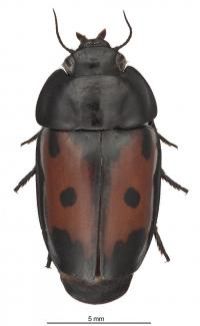New Beetle Species Discovered, Rare ‘Spectacular Guyane False-Form Beetle’ Lives With Ants [PHOTO]

A newly discovered beetle in French Guiana has been identified by scientists from the Smithsonian Institution.
Four specimens of the Spectacular Guyane False-form beetle, or Guyanemorpha spectabilis, taken from other institutions and private collections were used to confirm the existence of the beetle species. The findings were published in the journal ZooKeys.
"This surprising large and colorful pseudomorphine came as a shock to me, as all other species of the Tribe in the Western Hemisphere are quite dull brown, dark reddish, or blackish with no, or little, color contrast on the upper surface," Terry L. Erwin, author of the study, said in a statement.
"In the world of entomology this new species can be only compared in its rare characteristics to the Olinguito," he added, describing the new mammal species found earlier this year.
The Spectacular Guyane False-form beetle lives in lowland parts of French Guiana in South America. While scientists have yet to discover their way of life, the beetles belong to the Pseudomorphini Tribe, a genus known to live among various ant species.
"The pseudomorphines are a very interesting evolutionary off-shoot of the normal carabid morphotype in both form and function and are only just now beginning to be understood in North America,” Erwin said.
This isn’t the first beetle discovered in South America this year.
Among 60 new species discovered in the Suriname rainforest, the Lilliputian beetle, one of the smallest beetles in South America, was found by a team of scientists. Its antler-like antennas may suggest the dung beetle belongs to a new genus.
“Dung beetles play critical ecological roles that help support healthy ecosystems. By burying dung, they regulate parasites and disease, disperse seeds and recycle nutrients to promote plant growth,” Trond Larsen, a tropical ecologist on the expedition team, told the (U.K.) Telegraph.
As for the Spectacular Guyane False-form beetle, learning more about the new species may come as a challenge, Erwin said.
“The fact that species of related genera in South America are living with arboreal ants will make learning about them far more difficult. Insecticidal fogging gets adults of these species, but only tearing apart arboreal Azteca ant nests while suspended in a tree will produce their larvae, and that is not for carabidologists faint of heart," he said.
© Copyright IBTimes 2024. All rights reserved.




















